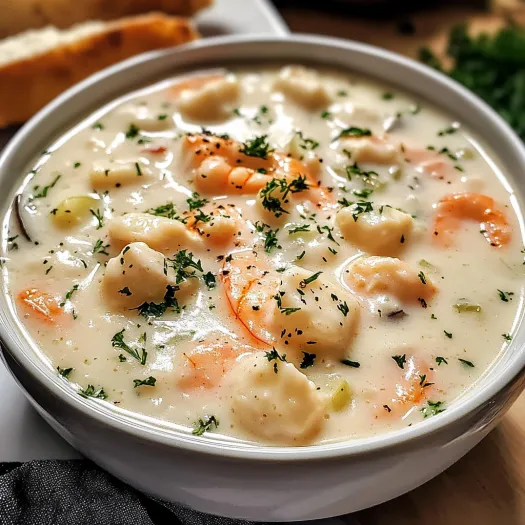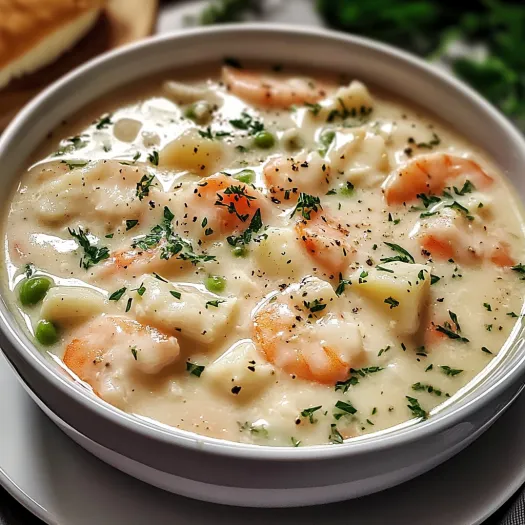 Pin
Pin
This creamy seafood chowder transforms ordinary evenings into special occasions with its rich texture and delicate seafood medley. Every spoonful delivers comfort and luxury in equal measure, making it my go-to recipe when I want to impress without spending hours in the kitchen.
I first created this chowder when unexpected guests arrived on a stormy evening. Using what I had in my freezer and pantry, this soup was born out of necessity but has become our family's most requested special occasion dish ever since.
Ingredients
- Unsalted butter: adds richness while allowing you to control the saltiness level
- Olive oil: prevents butter from burning and adds a subtle flavor dimension
- Onion, garlic, celery, and carrots: create the aromatic base that flavors the entire chowder
- Potatoes: add heartiness and naturally thicken the broth as they cook
- Seafood broth: intensifies the ocean flavor but chicken broth works wonderfully too
- Bay leaf and thyme: provide classic herbal notes that complement seafood perfectly
- Heavy cream and milk: create that signature velvety texture without becoming too heavy
- Shrimp, scallops, and white fish: offer varied textures and flavors; look for fresh or flash-frozen seafood for best results
- Fresh parsley: brightens the final dish with color and freshness; always add just before serving
Step-by-Step Instructions
- Create The Flavor Base:
- Heat butter and olive oil in a large heavy bottomed pot until the butter melts completely and begins to foam slightly but not brown. Add diced onion, garlic, celery, and carrots to the pot and sauté gently for a full 5 minutes until vegetables soften and become aromatic. Take your time with this step as it builds the foundation of flavor for your entire chowder.
- Develop The Broth:
- Add the diced potatoes and stir to coat them in the buttery vegetable mixture before adding your broth, bay leaf, and thyme. Bring this mixture to a gentle boil, watching carefully as it heats. Once bubbling, reduce the heat immediately to maintain a steady simmer until the potatoes are fork tender, which takes about 15 minutes. Test a larger piece of potato to ensure doneness.
- Create The Creamy Base:
- Pour in the cream and milk, stirring gently but constantly to incorporate them fully into the hot broth. The liquid should take on a beautiful creamy appearance, but avoid boiling at this stage which could cause the dairy to separate. The mixture should be steaming but not bubbling vigorously.
- Cook The Seafood:
- Gently add your seafood to the pot, starting with firmer fish chunks followed by scallops and finally the shrimp. The residual heat will cook the seafood perfectly, keeping it tender. Simmer very gently for just 5 to 7 minutes until the shrimp turn pink and the fish flakes easily. Overcooking will toughen the seafood, so watch closely.
- Finish And Serve:
- Season thoughtfully with salt and pepper, tasting as you go until the flavors brighten. Remember that seafood brings natural saltiness, so add gradually. Remove the bay leaf before ladling into warmed bowls. Sprinkle with fresh parsley just before serving for a burst of color and fresh flavor.
 Pin
Pin
My secret ingredient is actually patience during the initial vegetable sautéing stage. My grandmother taught me that rushing through this step results in a less flavorful base. When I take my time with the aromatics, the difference in the final chowder is remarkable; the depth of flavor transports me back to childhood dinners at her coastal home.
Storing Your Seafood Chowder
Seafood chowder is best enjoyed fresh as the delicate texture of shrimp and scallops changes when reheated. If you must store leftovers, refrigerate in an airtight container for no more than two days. Reheat gently over low heat, stirring frequently to prevent the cream from separating. Never bring leftover chowder to a boil as this will toughen the seafood beyond recognition and potentially cause the dairy to separate.
Make It Your Own
This chowder welcomes customization based on what looks freshest at your market. Lobster chunks add luxury, while clams or mussels bring a more rustic appeal. For a New England style variation, add corn kernels in the final cooking stage. If you prefer a dairy-free version, coconut milk creates a surprisingly compatible flavor with seafood, though the texture will be slightly different. Those watching calories can substitute half and half for the heavy cream with minimal impact on richness.
Serving Suggestions
While a crusty baguette is the traditional accompaniment, try serving this chowder in a bread bowl for an impressive presentation. A simple green salad dressed with lemon vinaigrette provides a refreshing counterpoint to the rich soup. For wine pairing, choose a crisp unoaked Chardonnay or Sauvignon Blanc that won't overpower the delicate seafood flavors. During summer months, serve the chowder just slightly cooler than piping hot and garnish with fresh dill instead of parsley for a brighter flavor profile.
 Pin
Pin
The History Behind The Bowl
Seafood chowders trace their origins to fishing communities along coastal regions where using the daily catch in hearty soups provided sustenance for hardworking families. Originally thickened with ship biscuits and later potatoes, these soups evolved as dairy became more readily available. The word chowder itself likely comes from the French chaudière or cauldron, showing how deeply this dish is connected to communal cooking traditions. Each coastal region, from New England to the Pacific Northwest, has developed its own variation, making chowder a true American culinary tradition worth preserving and personalizing.
Frequently Asked Questions About the Recipe
- → What type of white fish works best in seafood chowder?
Firm white fish that holds its shape when cooked works best in chowder. Cod, haddock, halibut, and pollock are excellent choices as they won't break down too much during cooking while still absorbing the flavors of the broth. Choose fresh fish whenever possible for the best flavor and texture.
- → Can I make this chowder ahead of time?
You can prepare the base of the chowder (everything before adding the seafood) up to 24 hours ahead. When ready to serve, reheat the base gently, then add the seafood and simmer just until cooked through. This prevents overcooking the delicate seafood while still giving you a head start on preparation.
- → How can I thicken my seafood chowder without adding flour?
For a naturally thickened chowder without flour, mash some of the cooked potatoes against the side of the pot with a wooden spoon and stir them back into the broth. You can also purée a portion of the vegetables and broth, then return this mixture to the pot. The natural starches provide body without altering the flavor.
- → What can I substitute for heavy cream to make this lighter?
To create a lighter version, replace heavy cream with half-and-half, evaporated milk, or a combination of whole milk and Greek yogurt. For dairy-free options, full-fat coconut milk or cashew cream can provide similar richness. Note that lighter substitutions may result in a slightly thinner consistency.
- → What's the best way to reheat leftover seafood chowder?
Reheat leftover chowder gently over low heat, stirring occasionally until just warmed through. Avoid boiling as this can make the seafood tough and cause the cream to separate. If the chowder seems too thick after refrigeration, thin it with a little milk or broth. Consume leftovers within 2 days for best quality.
- → What sides pair well with seafood chowder?
Crusty bread or oyster crackers are classic pairings that provide textural contrast and are perfect for dipping. A simple green salad with a light vinaigrette offers freshness that balances the richness of the chowder. For a more substantial meal, consider serving smaller portions of chowder with a half sandwich or crab cakes.
